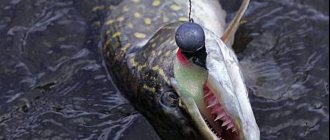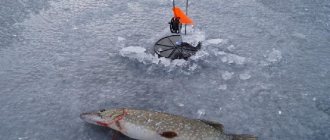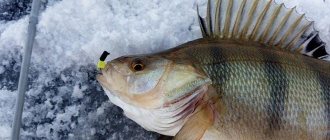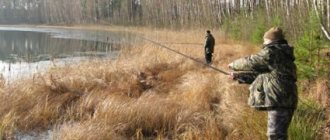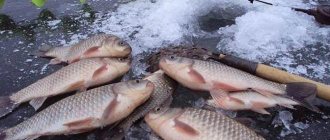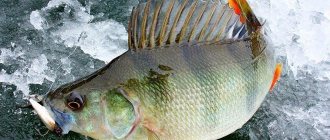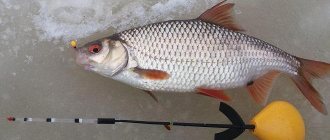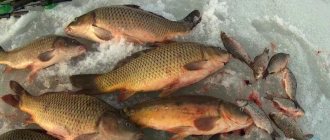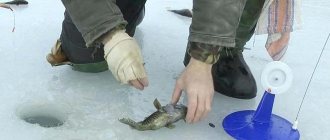Description of the species
Rotan has long been considered an extremely harmful fish that interferes with the population of other species in small bodies of water. This opinion is not wrong. The fish is indeed distinguished by quite aggressive behavior and vitality. When entering a new body of water, the individuals began active reproduction, surviving other fish from their usual places. So gradually the rotan could capture the entire water area, destroying all competitors.
As a result of this behavior, the fish spread throughout all water bodies of the country. But soon the individuals stopped behaving this way, simply occupying an ecological niche among other fish. Due to its unpretentiousness, rotan survives in any place. But not everywhere fish can survive for a long time. If active fishing is underway, all individuals can simply be caught. This is facilitated by extraordinary gluttony and an almost complete lack of neatness. For the same reasons, pike is considered a threat to rotan.
The ease of catching fish is further enhanced by its gastronomic value. Rotan has white meat with no small bones. Suitable for almost any preparation. But the size of the fish can cause inconvenience. In many reservoirs, individuals do not exceed the size of a finger. But in the right conditions, rotan can grow up to 50 cm in length.
Success in catching rotan is almost guaranteed to anyone who can find the right body of water. Fish can live without problems where other species cannot exist. Dirty, overgrown water is no problem for her. Therefore, for urban residents, rotan fishing is an excellent opportunity to spend leisure time and return with a guaranteed catch. You can use almost any gear, since rotan is unpretentious and does not differ in attentiveness. But for the most effective fishing, it is important to choose the right time, place and equipment.
Rotan behavior in winter
Any fish changes its behavior depending on the time of year. The same applies to rotan. It is better to start fishing in November or December. During this period, the habits of fish under the ice accompany an abundant catch. Almost immediately after the surface of the reservoir freezes, the fish stops changing their location. Where rotan was in summer, it will be there in winter.
In summer, individuals swim near the shore. Thickets of grass make them feel safe. In such places the depth usually does not exceed one meter.
As soon as winter comes, the grass disappears. This means that rotan needs to find a new place. This is facilitated by decreased oxygen levels near the coastline. As a result: the fish moves towards the reservoir, being at a depth of about 1.5 meters.
Oxygen starvation, characteristic of winter, affects rotan less than other fish. But he begins to move noticeably slower, more passively and more cautiously.
Fishing places
Rotana in winter should be looked for where there is vegetation, submerged branches or snags at the bottom of the reservoir . Rotan requires shelter, so it is unlikely to be found on a clean sandy bottom. If the specified conditions are met, then rotan can be found even at depths of several meters, although its main habitats are still shallow water. The aquatic plants favored by rotan are elodea and hornwort, in the thickets of which numerous aquatic invertebrates live.
Based on the type of reservoir, rotan habitats are divided into:
- Peat quarries. In these reservoirs, rotan is often the only inhabitant.
- Sand quarries. If there is underwater vegetation at the bottom of such reservoirs, then rotan may well be their inhabitant. Here it can coexist with perch, crucian carp and pike. Pike is a regulator of rotan numbers, and in such reservoirs there is a natural balance of ichthyofauna.
- Ponds. Many city ponds are inhabited by rotan, and they even host amateur competitions for catching this “Russian bass.”
- Forest lakes. Small forest lakes are subject to freezing in winter, so only crucian carp and rotan survive here.
- The banks of large reservoirs are densely overgrown with grass. Here, the species composition of the ichthyofauna can include a wide variety of fish, for example, tench and rudd, and all the inhabitants of the reservoir coexist peacefully.
Many fishermen believe that rotan, having settled in a reservoir, displaces other fish from it, eating eggs and being a food competitor. In most cases this is not true.
Expert opinion
Knipovich Nikolai Mikhailovich
Zoologist, hydrobiologist. I am interested in fishing at a professional level.
Interesting! In the dead of winter, when there is a deficiency of oxygen, rotans gather into dense clumps of several dozen individuals, which are enveloped in mucus. In this form, they can even survive freezing of a reservoir.
Habitat of rotan
It is difficult to find a more tenacious fish than rotan. The predator is able to survive almost anywhere. According to this parameter, the fish easily outperforms its famous relative, the carp. Swampy, overgrown, polluted areas - fish can overwinter everywhere.
Fisherman near the hole during winter fishing for rotan
It is easiest to find individuals in small lakes, ponds or overgrown bodies of water. Standing water seems to be the most attractive for rotan. Strong currents interfere with the normal life of this species.
Rotan can be found in almost any lakes or ponds in the middle zone. There is no need to list specific bodies of water, since there are really a lot of them. Often rotan is adjacent to other fish. You can find reservoirs with exclusively this species.
Where to look for large specimens
In reservoirs densely populated with rotan, fish can be found in any part. But large individuals live in specific conditions that do not apply to all areas. It is better to fish near the shore, in shallow water. It is good if it is covered with aquatic vegetation. It is recommended to look for individual objects that can serve as shelter for fish: snags, logs, branches, etc.
Standard fishing for rotan involves creating several holes and periodically walking around them. If the target is a large individual, it is more logical to constantly walk on the ice and drill holes, looking for the best place.
Large rotan is extremely rare. Therefore, catching it should be approached with increased attention. Especially if the body of water used does not provide good living conditions. A large rotan is usually found in a certain place, alone. All small representatives of the species will quickly feed on it. Therefore, you can catch a large specimen with a fairly large bait.
Search tactics
Arriving at a pond, the angler must drill several holes at a distance of 5-10 meters from each other. It is recommended to drill holes from the periphery to the center of the reservoir . Then the holes are fished one by one. In some holes you manage to catch several rotans, others remain empty. You should remember the catchable holes and return to them periodically. Obviously, in these areas of the bottom there are favorable conditions for rotan, and on them it accumulates in certain quantities.
On the first ice, rotan is active, so there is no need to wait a long time for a bite; it is better to move to another hole.
Benefits of first ice
The period of first ice in late autumn is the best for fishing for rotan. This is due to several factors at once. Fish during this period are the most voracious, and therefore less careful.
Catch of rotan during winter fishing
The advantage of fishing on the first ice is that when the shallow water freezes, some fish remain in their places. They are able to spend the entire winter in this position, as the body gradually begins to become overgrown with a layer of protective mucus. You can cut down an entire layer of ice with individuals located in it.
Rotan lives in closed, shallow waters. These areas experience the fastest freezing when winter arrives. Therefore, here fishermen often open their fishing season on the ice.
Areas where water borders vegetation are the most preferred habitat for large individuals. So, various bays and shallow waters will be a real gift for an experienced fisherman.
Gear for fishing on the first ice
They catch rotan on the first ice using different methods. Both active and passive fishing methods are effective. Since the fish are not very attentive, even self-made gear can be used. But store-bought ones are often much more thoughtful and effective.
The most important requirement for a rod for such an activity is its elasticity. The fish swallows the bait quite sharply, and after that it begins to struggle violently. So fragile rods can break. For the same reason, it is worth paying close attention to the strength of the fishing line and gear.
It is not recommended to use fishing line with a diameter smaller than 0.14. Otherwise, there will be a high probability of a break at the most inopportune moment. The risks are especially high when fishing in shallow water. Don't worry about the thick line being noticeable. Rotan does not pay any attention to such trifles. In an effort to profit faster, his attentiveness instantly decreases.
An important parameter for effective fishing is the correct balancing of gear. They should be in the water quite naturally. For balancing, you can use regular insulating tape. Fishing with a balance beam is considered one of the most suitable for catching rotan. This method involves the active movement of the fisherman from one hole to another.
It is better to choose a hard, springy nod. This will allow you to play with bait quite often and attract a predator. The jigs used are large, and you definitely can’t do without a hard nod. The mobility of the bait is facilitated by the elasticity of the fishing rod itself.
Catching rotan does not require the use of any invisible or sophisticated gear. The simplest fishing rods and baits, when used correctly, guarantee a rich catch.
Catching rotan in winter video
Catching rotan in winter on the first ice video
Fishing in Asino - catching rotan, first ice, underwater video shooting.
Rotana monsters on the first ice
First ice on rotan
Valera caught the biggest one from our company today. For 450 g! The fishing turned out great, although at first I couldn’t find an approach to rotan. But after lunch he was rehabilitated, apparently, by his example he showed the rotan how to eat. I didn’t have any big ones today, although I really wanted to.. Maybe next time? Our catches: I have 4, Yura and Sergei have 6 each, Valera has 9 kg.
Catching burbot with a snooker in winter
Chinese echo sounders for winter fishing >>
Baits and groundbait
Rotan bites on almost any bait. But the most practical options are chicken skin or cow udder. They are able to stay on the hook for a very long time, overcoming significant effort from the fish. With due attention and dexterity, you will rarely have to change such bait.
The shape of the bait should be triangular, as this type contributes to excellent retention on the hook and constant fluttering in the water. This fluttering attracts rotan most of all.
You can use chicken liver, fish meat, lard, worms, maggots and similar animal bait as bait. Rotan is indiscriminate and greedy, so the choice makes virtually no difference.
First ice fishing tactics
Catching rotan on first ice requires preliminary preparation from the fisherman. Main stages:
- drilling several holes in the surface of the reservoir, arranging them in a checkerboard pattern;
- feeding fish using cheap bait such as giblets, worms, etc.
- moving around the holes with periodic play with bait.
Feeding rotan is not necessary everywhere. In some reservoirs the population is so large that there is simply no need for this. If there is any doubt about the catch, it is better to feed it.
Moving along the holes and playing with a jig, the fisherman catches fish. The bite usually begins immediately after the start of fishing. But you shouldn’t overuse it, so after catching 3-4 individuals you need to change the hole. Within 15 minutes, the previous hole will “rest” and you can resume fishing in it again. At the same time, there are no restrictions on the prey of this predator, since rotan is capable of surviving all other species and capturing a reservoir. It is considered a pest that is not a sin to catch.
The rotan's body is small in size compared to its head. But large individuals are perfect for preparing various dishes. The fish meat is quite juicy and tasty, and it cooks quickly. So fishing will not only be a great pastime, but also a way to get delicious food.
Fishing technique
Winter fishing for rotan with a spinner is somewhat specific and differs from the usual hunting for perch or pike perch. A spoon with a piece of meat or other bait attached is lowered to the very bottom. Then it slowly rises by 5–10 cm, followed by a long pause of up to ten seconds. If there are no bites, the fisherman makes short strokes of the fishing rod and stops again.
If the rotan takes sluggishly in the bottom layer or there are no bites at all, then it is advisable to raise the spoon by 30–40 cm and repeat the wiring described above. Don’t forget that a predator can take you right under the ice, so don’t forget to check the upper horizon.
He takes the rotan spinner in different ways. When it is active, the bite is clearly transmitted to the hand and is somewhat reminiscent of a perch poke. In this case, the hook must follow immediately, otherwise the fish will safely avoid being caught.
When the rotan is sluggish, its bite is reflected on the nod in the form of slow swaying. There is no need to rush here; it is better to strike when the predator lifts the spoon up.
It happens that rotan fiddles with the bait on the hook. Then his bite is transmitted in the form of a small trembling nod. Under such circumstances, it is also worth waiting a little, allowing the fish to swallow the bait and then hooking.


